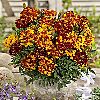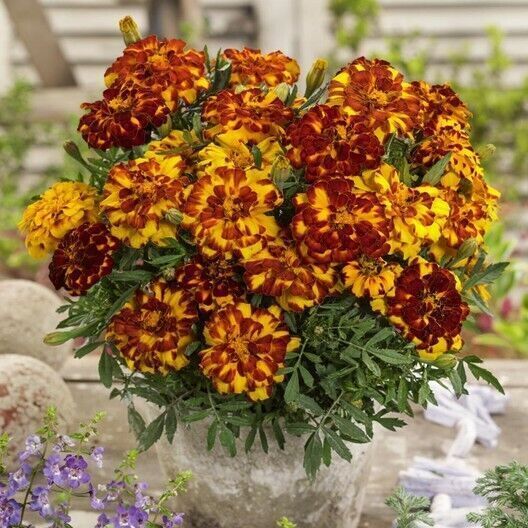French Marigold Seeds Durango BOLERO Dwarf Beneficial Plant Non-GMO 100 SEEDS
Pure Seed ? Non-GMO ? Fresh ? No Filler
PRODUCT INFORMATION
Beautiful Bolero Marigolds are a fiery mix of bold colors. Petals are a deep, dark orange that are offset by a brilliant burst of yellow at the center. Marigold Bolero is sure to stand out in your garden!
French Marigolds are a popular companion planting for veggies as they are known to help repel harmful pests! Easy to establish from seed, this dwarf variety won't grow more than 12 inches tall, but these large blooms are far from puny!If you need a pop of colour in the garden that endures Spring, Summer and Autumn, then you really can?t go past a French Marigold. With a long list of benefits for the garden and in the home, as well as being a gorgeous cut flower, you won?t mind that these scented beauties will re-seed every year.
Bees and Butterflies love them!
The Marigold is certainly one of the most planted annual flowers in the whole wide world. They have a fabulous reputation as a stand out companion plant for vegetables, such as tomatoes, and are used by cottage gardeners to attract important and much loved pollinators like bees and butterflies.
They propagate ever so quickly.
It?s best to plant them in early-late Spring, about 1cm deep with a quarter of a teaspoon of fertilizer sprinkled around the top. It?s important to keep the soil moist for the first 10-20 days. The seeds will take 1-2 weeks to germinate. Best of all, they are very simple and easy for gardening beginners, who will be growing their first flowers seeds in no time at all
Saving seeds...sprinkles...
As you can see below, you must deadhead your Marigolds regularly for a number of reasons, which include:
encouraging regular blooming
avoiding the plant wilting and going to seed
keeping flower heads for seed -saving.
It?s really easy to snap off the flower heads and drop them all over the ground so they will self-seed later. I usually do this during the balmy summer nights on my nightly evening garden walk (best done with a glass of local wine in one hand, leaving the other free to sprinkle seeds).
Ensure that you prick out their first three flowers, so that the plant bushes out to each side, then there will be more blooms for the life of its growing season if you do this at the beginning.
It?s also a green manure.
All types of Marigolds are extremely popular with Permaculture and market gardeners, many gardeners plant them to stop nematodes, cabbage worms, whitefly, aphids and many other vegetable and foliage damaging insects.
These darling plants also lure and woo useful insects like praying mantis, lacewings and ladybirds with their beautiful scent.
I know a couple of adventurous experimental gardeners who have used the spent foliage at the end of the season to chop up and turn it into the soil, as a green manure, with the aim of keeping soil-borne nematodes at bay. They believe that it has been successful and now I must give this a try. It would also be a great addition to the compost heap.
Who can go past bright colours and scent?
It?s hard to pass by these beauties, with all their benefits.
HAPPY GARDENING!
FAST FACTS
- Name: French Marigold Seeds - Bolero
- Botanical Name: Tagetes patula
- Life Cycle: Annual
- Light Requirement: Full Sun
- Planting Season: Spring
- Plant Type: Tall fern-like stems with large, orange and yellow flowers
- Features: Heirloom, Attracts Pollinators, Attracts Hummingbirds, Fragrant, Deer Resistant, Drought Tolerant, Cut Flower Garden, Easy to Grow & Maintain, Container Garden, Edible
- Color: Yellow, Orange
- Blooms: Summer, Late Summer, Early Fall, Fall
- Plant Height: Up to 12 inches
- Plant Spacing: 12 inches
- Planting Depth: 1/16 inch
- Sowing Method: Start Indoors, Direct Sow
- Cold Stratification: No
- Hardiness Zones: 1, 2, 3, 4, 5, 6, 7, 8, 9, 10
- Ships: Year Round
PLANTING INSTRUCTIONS: MARIGOLDS
WHEN TO PLANT MARIGOLD SEEDS: Direct sow Marigold seeds after all threat of frost has passed - it's recommended that you wait approximately 1-2 weeks after the final frost date. Marigolds can also be sown indoors approximately 50-60 days before your final frost.
WHERE TO PLANT MARIGOLD SEEDS: Marigolds are tolerant of most types of soil, and enjoy warm, Full Sun conditions. Marigolds do best in rich, well draining soil that remains moist, though once established can be somewhat drought tolerant as well. If planted in cool, or moist locations, Marigolds are susceptible to powdery mildew.
HOW TO PLANT MARIGOLD SEEDS: Sow Marigold seeds directly onto the surface of the soil and firmly compress. Don't cover your seeds, as Marigolds require sunlight in order to germinate.
HOW TO CARE FOR MARIGOLDS: Once planted, Marigolds require very little by way of care. Typically, you only need to water manually if the soil has gotten dry or dusty to the touch, or if it's been more than 2 weeks since any sort of natural rainfall. You can increase your blooms significantly by deadheading your spent blooms. Dried, spent blooms can be stored in a dry, cool location that gets minimal exposure to sunlight, and if planted, the seeds in the seed heads can produce additional marigolds the following year.
Free shipping on all orders in the USA.
Our amazing support team is here to help. Text us at 678 316 0940 and get an instant response
Your Payment is Secure and So is your Purchase. Simply return it within 30 days for an exchange.
Grab a hosting plan for that small business or personal website. Fast Setup, great speeds, low prices. Managed Hosting Too.Text us at 678 316 0940
















